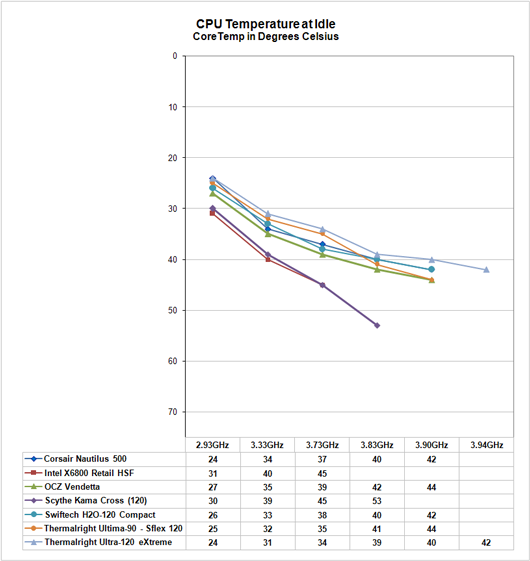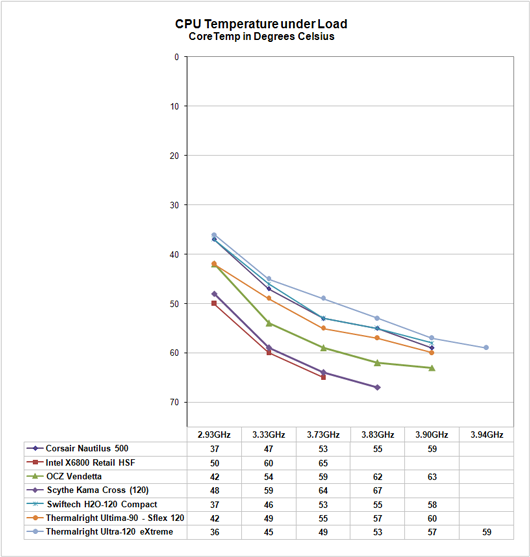New Mid-Priced Coolers from OCZ and Scythe: The Small and the X of It
by Wesley Fink on October 1, 2007 12:05 AM EST- Posted in
- Cases/Cooling/PSUs
Scaling of Cooling Performance
Decent performance at stock speeds is one thing, but we were interested in seeing how both these midrange air coolers scaled in cooling higher overclocks. With the change in test beds and temperature measurement utilities the method of displaying the test results has been changed. The scale is now reversed with zero on top and 75C on the bottom. This means the best performance is now displayed as the highest points in the graph (representing lowest temperature). The reference Intel retail cooler is now at the bottom of the results chart since it exhibits the poorest performance (highest temperatures) of our tested coolers.
The Scythe Kama Cross continues to be a disappointment, even though we tested with the larger and higher output Thermalright S-FLEX 120mm fan. Performance is only 1C better than the Intel retail at most overclocks, though the Kama Cross does reach a higher 3.83GHz compared to 3.73GHz with the retail cooler. Frankly, the smaller stock 100mm fan gave up little in performance to the well-regarded S-FLEX, indicating the fan is not the issue in this design - the heatsink itself appears the limitation.
With the stock 100mm fan performance was within 1C of the 120 fan results across the curve. It was a puzzle at first as to why Scythe equipped the Kama Cross with a 100mm fan when it was clearly designed to work with a 120mm fan. We can only conclude that after developing the cooler, Scythe realized the performance meant the Kama Cross would sell in the midrange and they did whatever was necessary to reduce the Kama Cross cost.
Looking closely at the curves of the top coolers tested, the OCZ Vendetta follows the pattern of the top coolers very closely, with slightly poorer performance across the speed curve. This is exactly what would be expected with a top midrange cooler. The Vendetta does not quite reach the top speed of the best and most expensive, but it comes close. It also scales well.
Cooling efficiency of the OCZ Vendetta and Scythe Kama Cross were then compared under load conditions to the retail HSF and other recently retested CPU coolers. Load testing can be very revealing of a cooler's efficiency. A basically flat line, particularly form 3.73GHz upward, indicates the cooler is still in its best cooling range. A line that is falling rapidly indicates a cooler nearing the end of its ability to cool efficiently. Lines which parallel the best coolers over a range of values are showing similar efficiency slopes.
The Kama Cross closely mirrored the Intel retail cooler. We would prefer a mirroring of the top Thermalright coolers indicating robust cooler scaling. By contrast the OCZ Vendetta, which is both smaller and handicapped by a smaller 92mm fan, mirrored the Ultima-90 and Ultra-120 eXtreme curves. This is very good performance.
As expected of a midrange cooler, the OCZ is warmer across the speed range at load than top coolers. While performance variations are greater, the curve still mirrors the top air coolers and reaches almost as high as the best air and water coolers.
Decent performance at stock speeds is one thing, but we were interested in seeing how both these midrange air coolers scaled in cooling higher overclocks. With the change in test beds and temperature measurement utilities the method of displaying the test results has been changed. The scale is now reversed with zero on top and 75C on the bottom. This means the best performance is now displayed as the highest points in the graph (representing lowest temperature). The reference Intel retail cooler is now at the bottom of the results chart since it exhibits the poorest performance (highest temperatures) of our tested coolers.
 |
| Click to enlarge |
The Scythe Kama Cross continues to be a disappointment, even though we tested with the larger and higher output Thermalright S-FLEX 120mm fan. Performance is only 1C better than the Intel retail at most overclocks, though the Kama Cross does reach a higher 3.83GHz compared to 3.73GHz with the retail cooler. Frankly, the smaller stock 100mm fan gave up little in performance to the well-regarded S-FLEX, indicating the fan is not the issue in this design - the heatsink itself appears the limitation.
With the stock 100mm fan performance was within 1C of the 120 fan results across the curve. It was a puzzle at first as to why Scythe equipped the Kama Cross with a 100mm fan when it was clearly designed to work with a 120mm fan. We can only conclude that after developing the cooler, Scythe realized the performance meant the Kama Cross would sell in the midrange and they did whatever was necessary to reduce the Kama Cross cost.
Looking closely at the curves of the top coolers tested, the OCZ Vendetta follows the pattern of the top coolers very closely, with slightly poorer performance across the speed curve. This is exactly what would be expected with a top midrange cooler. The Vendetta does not quite reach the top speed of the best and most expensive, but it comes close. It also scales well.
Cooling efficiency of the OCZ Vendetta and Scythe Kama Cross were then compared under load conditions to the retail HSF and other recently retested CPU coolers. Load testing can be very revealing of a cooler's efficiency. A basically flat line, particularly form 3.73GHz upward, indicates the cooler is still in its best cooling range. A line that is falling rapidly indicates a cooler nearing the end of its ability to cool efficiently. Lines which parallel the best coolers over a range of values are showing similar efficiency slopes.
 |
| Click to enlarge |
The Kama Cross closely mirrored the Intel retail cooler. We would prefer a mirroring of the top Thermalright coolers indicating robust cooler scaling. By contrast the OCZ Vendetta, which is both smaller and handicapped by a smaller 92mm fan, mirrored the Ultima-90 and Ultra-120 eXtreme curves. This is very good performance.
As expected of a midrange cooler, the OCZ is warmer across the speed range at load than top coolers. While performance variations are greater, the curve still mirrors the top air coolers and reaches almost as high as the best air and water coolers.










22 Comments
View All Comments
strikeback03 - Thursday, October 4, 2007 - link
should be better, but fitting them would be a problem as they would have to be really thin. Plus small fans are usually loud. Best way to make this cooler worth anything would probably be a shroud to block air from heading straight out the bottom or to the sides.DrMrLordX - Monday, October 1, 2007 - link
Were it not for the noise on the Vendetta, I'd say it would be entirely preferable to the ever-popular Arctic Cooling Freezer HSFs. At that price point, with that performance, the only reason I could see going for a Freezer 7 Pro would be the noise were I sensitive to that sort of thing.